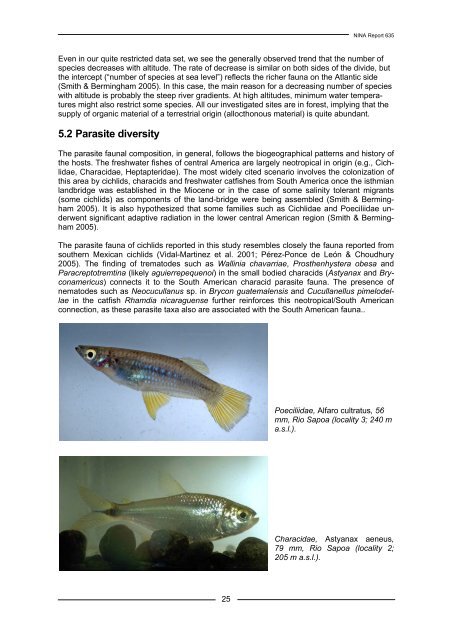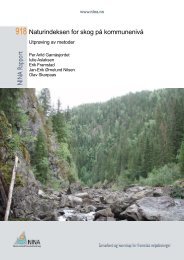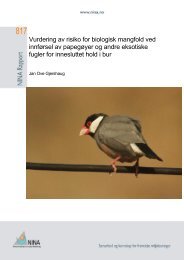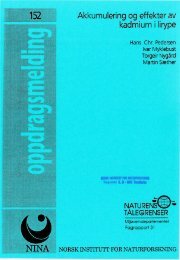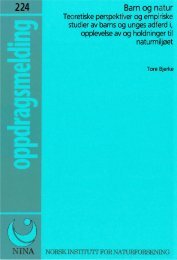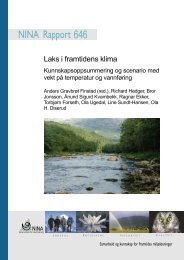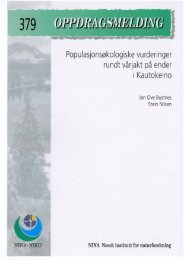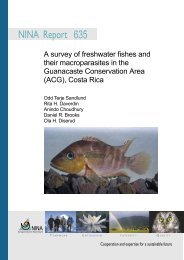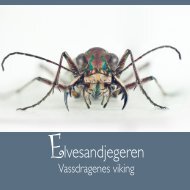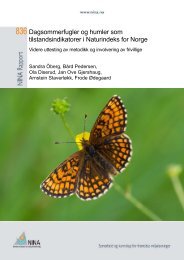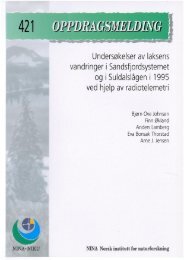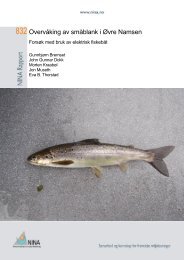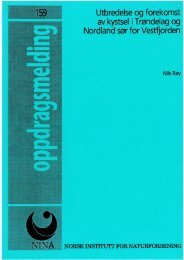A survey of freshwater fishes and their macroparasites in the ... - NINA
A survey of freshwater fishes and their macroparasites in the ... - NINA
A survey of freshwater fishes and their macroparasites in the ... - NINA
Create successful ePaper yourself
Turn your PDF publications into a flip-book with our unique Google optimized e-Paper software.
25<br />
<strong>NINA</strong> Report 635<br />
Even <strong>in</strong> our quite restricted data set, we see <strong>the</strong> generally observed trend that <strong>the</strong> number <strong>of</strong><br />
species decreases with altitude. The rate <strong>of</strong> decrease is similar on both sides <strong>of</strong> <strong>the</strong> divide, but<br />
<strong>the</strong> <strong>in</strong>tercept (“number <strong>of</strong> species at sea level”) reflects <strong>the</strong> richer fauna on <strong>the</strong> Atlantic side<br />
(Smith & Berm<strong>in</strong>gham 2005). In this case, <strong>the</strong> ma<strong>in</strong> reason for a decreas<strong>in</strong>g number <strong>of</strong> species<br />
with altitude is probably <strong>the</strong> steep river gradients. At high altitudes, m<strong>in</strong>imum water temperatures<br />
might also restrict some species. All our <strong>in</strong>vestigated sites are <strong>in</strong> forest, imply<strong>in</strong>g that <strong>the</strong><br />
supply <strong>of</strong> organic material <strong>of</strong> a terrestrial orig<strong>in</strong> (allocthonous material) is quite abundant.<br />
5.2 Parasite diversity<br />
The parasite faunal composition, <strong>in</strong> general, follows <strong>the</strong> biogeographical patterns <strong>and</strong> history <strong>of</strong><br />
<strong>the</strong> hosts. The <strong>freshwater</strong> <strong>fishes</strong> <strong>of</strong> central America are largely neotropical <strong>in</strong> orig<strong>in</strong> (e.g., Cichlidae,<br />
Characidae, Heptapteridae). The most widely cited scenario <strong>in</strong>volves <strong>the</strong> colonization <strong>of</strong><br />
this area by cichlids, characids <strong>and</strong> <strong>freshwater</strong> cat<strong>fishes</strong> from South America once <strong>the</strong> isthmian<br />
l<strong>and</strong>bridge was established <strong>in</strong> <strong>the</strong> Miocene or <strong>in</strong> <strong>the</strong> case <strong>of</strong> some sal<strong>in</strong>ity tolerant migrants<br />
(some cichlids) as components <strong>of</strong> <strong>the</strong> l<strong>and</strong>-bridge were be<strong>in</strong>g assembled (Smith & Berm<strong>in</strong>gham<br />
2005). It is also hypo<strong>the</strong>sized that some families such as Cichlidae <strong>and</strong> Poeciliidae underwent<br />
significant adaptive radiation <strong>in</strong> <strong>the</strong> lower central American region (Smith & Berm<strong>in</strong>gham<br />
2005).<br />
The parasite fauna <strong>of</strong> cichlids reported <strong>in</strong> this study resembles closely <strong>the</strong> fauna reported from<br />
sou<strong>the</strong>rn Mexican cichlids (Vidal-Mart<strong>in</strong>ez et al. 2001; Pérez-Ponce de León & Choudhury<br />
2005). The f<strong>in</strong>d<strong>in</strong>g <strong>of</strong> trematodes such as Wall<strong>in</strong>ia chavarriae, Pros<strong>the</strong>nhystera obesa <strong>and</strong><br />
Paracreptotremt<strong>in</strong>a (likely aguierrepequenoi) <strong>in</strong> <strong>the</strong> small bodied characids (Astyanax <strong>and</strong> Bryconamericus)<br />
connects it to <strong>the</strong> South American characid parasite fauna. The presence <strong>of</strong><br />
nematodes such as Neocucullanus sp. <strong>in</strong> Brycon guatemalensis <strong>and</strong> Cucullanellus pimelodellae<br />
<strong>in</strong> <strong>the</strong> catfish Rhamdia nicaraguense fur<strong>the</strong>r re<strong>in</strong>forces this neotropical/South American<br />
connection, as <strong>the</strong>se parasite taxa also are associated with <strong>the</strong> South American fauna..<br />
Poeciliidae, Alfaro cultratus, 56<br />
mm, Rio Sapoa (locality 3; 240 m<br />
a.s.l.).<br />
Characidae, Astyanax aeneus,<br />
79 mm, Rio Sapoa (locality 2;<br />
205 m a.s.l.).


